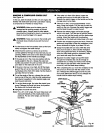
BASIC OPERATION OF THE RADIAL
ARM SAW
A radial arm saw can be usedfor straight-linecutting
operations such as cross cutting,ripping,mitering,
beveling, compoundcutting,and resawing. Itcan
make dado or moldingcuts with specialattachments.
This saw is designedto cut woodand woodcomposi-
tion productsonly.
The three-prong plugmust be plugged into a match-
ingoutletthat is properlyinstalledand grounded
accordingto all local codes and ordinances. Improper
connection ofthe equipment can resultin electric
shook. Check withan electricianor service personnel
ifyou are unsure about propergrounding. Do not
modify the plug;if itwillnot fitthe outlet,have the
correct outletinstalledby a qualifiedelectrician. Refer
to the Electricalpage of this manual.
TYPES OF CUTS
See Figure 35.
The radial saw makes cross cutsparallel withthe arm
(across the grain), and ripcuts squareto the arm (with
the grain). Each can be made withthe blade vertical
or beveled, instructionsfor making each kindof cut
are given later inthis section.
_lb WARNING: Allblades and cuttingaccessories
must be rated for at least5,000 rpm to prevent
possible injury.
CROSS CUTS
Cross cutsare made parallelto the arm. The blade is
pulled along the length ofthe radialarm withthe wood
secured.
There are several typosof cross cuts. A crossout
shows O"on the miter scale (arm straight) and O"on
the bevel scale (blade straight). A mitercutis made
withthe radialarm angled and the blade straight.A
bevel cutis produced withthe arm straightand the
blade angled.
A finaltype of cross cut isthe compound cross cut,
Both the arm and the blade are angled. Be thoroughly
familiar with makingcross cuts, bevel cuts, and miter
cuts before trying a compound miter cut.
Note: In crosscuts, the blade teeth point downas
they strikethe wood.In ripcuts, the teeth point
up as they strikethe wood.
_&, WARNING: NEVER make a cross cutwith the
shortedge of the wood parallelto the fence. Kick
back is likelyto occur,causing the workpieca to
be thrownback at you. Treat sucha workpiece
as a ripcut.
RIP CUTS
In ripcuts, the yoke is rotated90" left or rightand
lockedin place. The wood mustride firmly against the
ripfence. There are two orientationsof ripcuts- the
in-ripand the out-rip.The in-rippositionprovides
better visibility.Out-rip cutscan also be made with the
blade beveled,
In an in-ripcut, the yoke is rotatedto the left, which
putsthe blade in between the column and the motor.
The wood isfed from the righthand side.
In an out-ripcut, the blade is in front of the motor,and
the wood isfed from the left. Out-rip cuttingis recom-
mended onlywhen the blade isset 12 in. or more
from the fence.
,_. WARNING: Always make sure the bladeguard
and anti-kickbackpawls are in place and working
properlywhen making ripcutsto avoid possible
injury.
_lb WARNING: Always usea pushstickwithsmall
pieces of wood, and also to finishthe cut when
rippinga long narrow piece ofwood, to prevent
yourhands from getting close to the blade.
CROSSCUT
Q _'__BEVEL CUT
COMPOUNDCROSSCUT
Q __ RiPCUT
@ s v,,R,PCuT
Fig. 35
43 DIAFTSMIIIFRADIALSAW315.220381


















